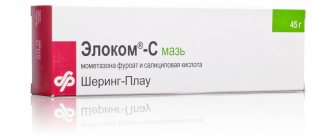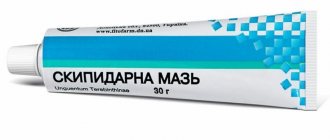Beloderm Express spray for external use 0.05% 50 ml bottle 1 pc. in Moscow
Pharmacological action: Interacts with specific receptors in the cytoplasm of the cell, the resulting complex penetrates the cell nucleus, binds to DNA and stimulates the synthesis of mRNA, inducing the formation of proteins, incl. lipocortin, mediating cellular effects. In some cells (for example, in lymphocytes) it causes suppression of mRNA. Lipocortin inhibits phospholipase A2, blocks the liberation of arachidonic acid and the biosynthesis of endoperoxides, PGs, and leukotrienes (which contribute to the development of inflammation, allergies and other pathological processes).
Affects all phases of inflammation. The anti-inflammatory effect is due to many factors. One of the leading ones is inhibition of phospholipase A2 with subsequent inhibition of the formation of pro-inflammatory mediators - PG and leukotrienes. In addition, it stabilizes cell membranes, incl. membranes of lysosomes, prevents the release of lysosomal enzymes and reduces their concentration at the site of inflammation. Inhibits the migration of neutrophils and macrophages to the site of inflammation and their phagocytic activity. Improves microcirculation, reduces vascular permeability, causes vasoconstriction of capillaries, and reduces fluid exudation.
The antiallergic effect develops as a result of a decrease in the synthesis and secretion of allergy mediators, inhibition of the release of histamine and other biologically active substances from sensitized mast cells and basophils, a decrease in the number of circulating basophils, suppression of the proliferation of lymphoid and connective tissue, a decrease in the number of T- and B-lymphocytes, mast cells , reducing the sensitivity of effector cells to allergy mediators, suppressing antibody formation, changing the body’s immune response.
The immunosuppressive effect is associated with suppression of the activity of T- and B-lymphocytes, as well as inhibition of the release of cytokines (interleukin-1, interleukin-2, interferon-gamma) from leukocytes and macrophages.
Antishock and antitoxic effects are associated with an increase in blood pressure (due to an increase in the amount of circulating catecholamines, restoration of the sensitivity of adrenergic receptors to catecholamines and vasoconstriction), activation of liver enzymes involved in the metabolism of endo- and xenobiotics.
It has a pronounced effect on all types of exchange. Stimulates gluconeogenesis in the liver, increases blood glucose levels (glucosuria is possible). Accelerates protein catabolism, especially in muscle tissue. Causes a redistribution of fat: increases lipolysis in the tissues of the extremities, promotes the accumulation of fat mainly in the face (moon face), neck, and shoulder girdle. Retains Na+ and water, stimulates the excretion of K+, increases the excretion of Ca+.
With long-term use, it suppresses the function of the hypothalamus-pituitary-adrenal system.
After parenteral (i.m.) and enteral administration, it is rapidly absorbed - the maximum effect (when taken orally) develops after 1–2 hours.
When using a combination of salts in one preparation, betamethasone disodium phosphate is well absorbed from the injection site and has a rapid effect; betamethasone dipropionate has a slower absorption, but provides a long-lasting effect.
When instilled into the conjunctival sac, it penetrates into the intraocular fluid, cornea, iris, choroid, ciliary body, and retina. Systemic absorption may be significant only when used in high doses or with prolonged use in children.
When applied locally to the skin, the intensity of absorption depends on a number of factors: the solvent (polypropylene components improve diffusion), the state of the epidermal barrier (inflammation and skin diseases increase absorption).
Binds to plasma proteins. Easily passes histohematic barriers, including placental ones. Partially excreted in breast milk. Biotransformed mainly in the liver, the resulting metabolites are inactive. Excreted by the kidneys.
Carcinogenicity, mutagenicity, effect on fertility
Long-term animal studies have not been conducted to evaluate the potential carcinogenicity or effects on fertility of topical betamethasone. Betamethasone was genotoxic in vitro
in the chromosomal aberration test on human lymphocytes (with metabolic activation) and
in vivo
in the micronucleus test on mouse bone marrow.
Beloderm Express
Beloderm Express (INN betamethasone) is a long-acting glucocorticosteroid for topical use. Suppresses the functions of white blood cells and tissue monocytes. Prevents the migration of white blood cells into the inflammatory focus. Reduces the ability of monocytes to absorb large macromolecular complexes or corpuscles, bacteria, as well as the inflammatory and immune mediator interleukin-1. Prevents the destabilization of lysosome membranes, thereby preventing proteolytic enzymes from accumulating in the inflammatory focus. Makes capillary walls less permeable. Reduces the activity of connective tissue cells in the body that synthesize the extracellular matrix. Suppresses the activity of phospholipase, which hydrolyzes the phospholipid acyl chain in the sn-2 position, resulting in a decrease in the concentration of proinflammatory and nociceptive mediators prostaglandins and mediators of allergy and inflammation leukotrienes. Prevents an increase in the concentration of COX. Reduces the number of lymphoid cells, phagocytes, acidophilic and basophilic granulocytes due to their movement from the blood to the lymph. Interferes with the synthesis of antibodies. When applied to the skin in the area of blood vessels, it exhibits a vasoconstrictor effect. It affects the metabolism of proteins, fats and carbohydrates: it activates the metabolic reactions of glucose formation from non-carbohydrate compounds, stimulates the absorption of amino acids by liver and kidney cells. Promotes the storage of glycogen by the liver, activating glycogen synthetase and the process of glucose formation from protein compounds. Prevents the absorption of glucose by adipocytes - adipose tissue cells. Promotes the accumulation of sodium ions and water in the body, and the elimination of potassium ions from the body. Prevents the absorption of calcium in the gastrointestinal tract, removes calcium ions from bone tissue and enhances their elimination along with urine. Exhibits a catabolic effect in peripheral tissues. When used locally (externally), the ability of the drug to achieve a therapeutic effect is due to its anti-inflammatory, antiallergic, vasoconstrictor (as a result of which exudation is suppressed) effect.
The anti-inflammatory potential of Beloderm Express is thirty times greater than that of hydrocortisone. The drug has no affinity for mineralocorticoid receptors. After application to the skin, about 12-14% of the dose used is absorbed into the systemic bloodstream (to a lesser extent when applied to intact skin, to a greater extent when used in an area of inflammation or applied under an airtight bandage). Beloderm Express is prescribed for skin diseases of various origins caused by both exogenous and endogenous causes, including eczematous skin lesions (coin-shaped, atopic, dyshidrotic eczema), infantile prurigo (prurigo), contact dermatitis, exfoliative dermatitis, pruritic lichenoid dermatitis, photocontact dermatitis , seborrhea, intertrigenous dermatitis, etc. The dose is selected by the doctor on an individual basis. Frequency of use: 2-6 times a day until the clinical picture improves, then 1-2 times a day. When using the drug in pediatric practice, as well as in persons with facial skin lesions, the duration of the medication course should be no more than five days. For viral and bacterial skin infections, as well as mycoses, the use of the drug is possible only under strict medical supervision. The same is true for patients in the post-vaccination period, as well as persons with diseases of the gastrointestinal tract (ulcerative-erosive lesions of the stomach and duodenum, inflammation of the mucous membrane of the esophagus, stomach, small intestine, etc.), and the cardiovascular system. If signs of skin irritation or individual intolerance appear, the use of Beloderm Express should be interrupted and appropriate symptomatic treatment should be carried out. When an infection occurs that has developed against the background of an existing disease, it is necessary to carry out antimicrobial therapy.
Contraindications
Hypersensitivity to betamethasone or to other corticosteroids or other components of the drug.
Viral infections, including post-vaccination reactions and chicken pox; viral skin infections (eg, herpes simplex, shingles, chicken pox); rosacea; rosacea-like (perioral) dermatitis, bacterial dermatoses, including tuberculosis and syphilis of the skin; fungal diseases, ophthalmic diseases (Beloderm, not intended for ophthalmic use) do not use under occlusive dressings (plaster)
Particular care should be taken when applying to the face.
Do not allow the drug to come into contact with the eyes or mucous membranes.
Do not use in the first trimester of pregnancy.
Long-term treatment and/or use on a large surface of the skin should be avoided, as absorption of the active substance is possible.
Beloderm Express 0.05% 50ml spray bottle for external use approx. in Izhevsk
From the endocrine system: decreased glucose tolerance, steroid diabetes mellitus or manifestation of latent diabetes mellitus, suppression of adrenal function, Itsenko-Cushing syndrome (including moon face, pituitary type obesity, hirsutism, increased blood pressure, dysmenorrhea, amenorrhea, myasthenia gravis , striae), delayed sexual development in children.
Metabolism: increased excretion of calcium ions, hypocalcemia, increased body weight, negative nitrogen balance (increased protein breakdown), increased sweating, fluid and sodium ion retention (peripheral edema), hypernatremia, hypokalemic syndrome (including hypokalemia, arrhythmia, myalgia or muscle spasm, unusual weakness and fatigue).
From the central nervous system: delirium, disorientation, euphoria, hallucinations, manic-depressive psychosis, depression, paranoia, increased intracranial pressure, nervousness or anxiety, insomnia, dizziness, vertigo, pseudotumor of the cerebellum, headache, convulsions.
From the cardiovascular system: arrhythmias, bradycardia (up to cardiac arrest); development (in predisposed patients) or increased severity of chronic heart failure, ECG changes characteristic of hypokalemia, increased blood pressure, hypercoagulation, thrombosis. In patients with acute and subacute myocardial infarction - the spread of necrosis, slowing down the formation of scar tissue, which can lead to rupture of the heart muscle; with intracranial administration - nosebleeds.
From the digestive system: nausea, vomiting, pancreatitis, steroid ulcer of the stomach and duodenum, erosive esophagitis, bleeding and perforation of the gastrointestinal tract, increased or decreased appetite, flatulence, hiccups. In rare cases, increased activity of liver transaminases and alkaline phosphatase.
From the senses: sudden loss of vision (with parenteral administration in the head, neck, nasal turbinates, scalp, deposition of drug crystals in the vessels of the eye is possible), posterior subcapsular cataract, increased intraocular pressure with possible damage to the optic nerve, tendency to develop secondary bacterial , fungal or viral eye infections, trophic changes in the cornea, exophthalmos.
From the musculoskeletal system: slower growth and ossification processes in children (premature closure of the epiphyseal growth plates), osteoporosis (very rarely - pathological bone fractures, aseptic necrosis of the head of the humerus and femur), rupture of muscle tendons, steroid myopathy, decreased muscle mass (atrophy); with intra-articular administration - increased pain in the joint.
Dermatological reactions: delayed wound healing, petechiae, ecchymosis, skin thinning, hyper- or hypopigmentation, steroid acne, stretch marks, tendency to develop pyoderma and candidiasis.
Allergic reactions: generalized (skin rash, skin itching, anaphylactic shock), local allergic reactions.
Local reactions: with parenteral administration - burning, numbness, pain, paresthesia and infection at the injection site, rarely - necrosis of surrounding tissues, scar formation at the injection site; with intramuscular injection (especially into the deltoid muscle) - atrophy of the skin and subcutaneous tissue.
Other: development or exacerbation of infections (the appearance of this side effect is facilitated by jointly used immunosuppressants and vaccination), leukocyturia, withdrawal syndrome.
With intravenous administration - blood flow to the face, convulsions.
For external use: rarely - itching, hyperemia, burning, dryness, folliculitis, acne, hypopigmentation, perioral dermatitis, allergic dermatitis, skin maceration, secondary infection, skin atrophy, stretch marks, prickly heat. With prolonged use or application to large areas of skin, systemic side effects characteristic of GCS may develop.
Note!
Description of the drug Beloderm spray 0.05% bottle 50 ml No. 1 on this page is a simplified author’s version of the apteka911 website, created on the basis of the instructions for use.
Before purchasing or using the drug, you should consult your doctor and read the manufacturer's original instructions (attached to each package of the drug). Information about the drug is provided for informational purposes only and should not be used as a guide to self-medication. Only a doctor can decide to prescribe the drug, as well as determine the dose and methods of its use.
Overdose
Excessive or long-term use of topical corticosteroids can cause depression of pituitary-adrenal function, leading to secondary adrenal insufficiency and symptoms of hypercortisolism, including Cushing's syndrome. Acute symptoms of hypercortisolism are usually reversible.
In case of overdose, appropriate symptomatic treatment is indicated. If necessary, electrolyte balance should be corrected. In case of chronic toxicity, gradual withdrawal of GCS is recommended.



